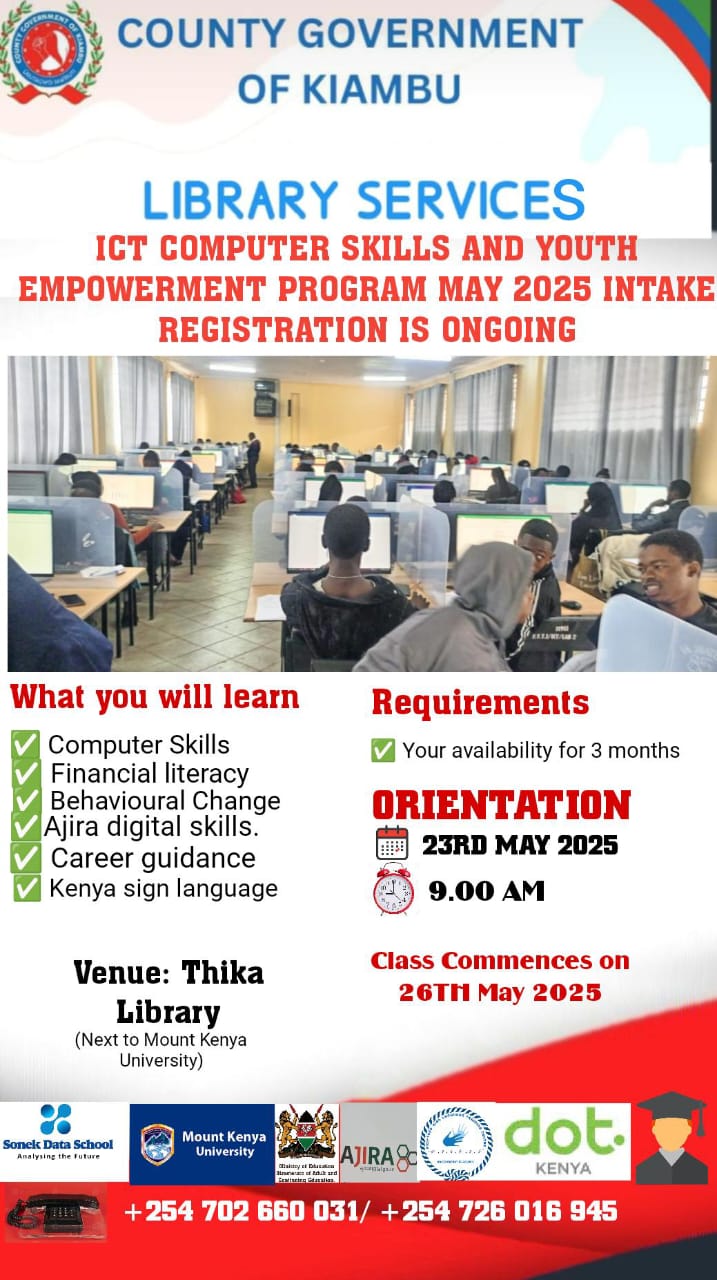Thika’s long journey to a city firmly on course
Thika’s long journey to a city firmly on course
By Enock Maroa
The plan to elevate Thika Town to Thika Industrial Smart City is progressing
well. The recently appointed ad hoc and county technical committees have
started working on a clear roadmap to achieve this transformation.
Last week, the committees met and agreed on a strategy to meet the
requirements of the Urban Areas and Cities Act. They have begun collecting
comprehensive data to prepare for Thika’s upgrade.
Thanks to Governor Kimani Wamatangi, Thika, once regarded as the industrial
hub of Kenya, is set to reclaim its lost glory by becoming a city.
The team confirmed that Thika meets the population requirement of 250,000
residents, with a population of 279,429, according to the 2019 National Census.
Thika’s infrastructure, including the Thika Superhighway, Thika-Garissa Road
and a railway line, supports local industries. Led by Vice-chair Planner T.G.
Ndorongo, the team visited key areas such as Thika Industrial Zone, educational
institutions, public parks, the administrative zone, and more to gather insights
on existing facilities.
Some of the notable places visited by the team include; Thika Industrial Zone,
Thika learning institutions, Thika urban public parks, Thika Administrative
Zone, Thika-Machakos boundary, Fourteen Falls, Ngoliba and Kilimabongo
satellite towns, Gatuanyaga, Munyu and Githima areas, Kang’oki dumpsite
where they witnessed the upcoming recycling industries, informal settlements in
thika, sports facilities such as Thika stadium, Thika-Ruiru boundary, Safaricom
Foundation and Mary Hill School, amongst others.
The team pushing the Smart City agenda paid a courtesy call to the office of the
County Executive Committee Member in charge of Lands, Housing, Physical
Planning, Municipal Administration and Urban Development, Ms Salome
Wainaina. The meeting was a moment to update the CECM on the significant
progress they had made towards transforming Thika.
During the meeting, Ms Wainaina praised the Committee’s efforts, saying, “I am
impressed with your work; what you have achieved in this period is remarkable.
Keep pressing on, and together we will achieve our goal of transforming Thika
Town into Thika Industrial Smart City.”
The town’s rapid growth, marked by numerous developments and expanding
educational institutions, underscores its readiness for this upgrade. The
Kang’oki dumpsite, the largest in Kiambu County, sorts waste for easier
disposal.
The primary goal of this initiative is to collect and analyse data on the
municipality as required by the Urban Areas and Cities Act amended in 2019.
This data will provide valuable insights for shaping the strategic report and
guiding the development of the Thika Industrial Smart City.
“Elevating our town to city status is not just a title change; it’s a significant step
towards greater economic development, improved infrastructure and enhanced
quality of life for all our residents,” said Mr. Martin Kangiri, the acting Chief
Officer.
Overall, the Thika Industrial Smart City Initiative aims to drive economic
development, create jobs, promote innovation, and improve the quality of life
for Kiambu County residents. Governor Wamatangi’s administration is lobbying
to elevate Thika to city status, benefiting Kiambu County and surrounding
regions.
Githurai Bodaboda group gets Ksh 1 million boost for their Sacco
Githurai Bodaboda group gets Ksh 1 million boost for their Sacco

By Njeri Karu
In a move to boost economic empowerment and self-reliance, Governor Dr. Kimani Wamatangi
honoured his pledge of Ksh 1 million to the Githurai 45 Kimwi Bodaboda Transport Co-operative Society.
During a colourful ceremony attended by thousands of people, the Governor enhanced the Sacco’s
funds to support and empower the bodaboda operators to run sustainable enterprises and engage in other income-generating projects.
The Sacco, started in March, has a membership of 500 riders drawn from Kiuu and Mwiki wards in Ruiru municipality. The association has 3,400 members, but only 500 have joined the Sacco. The group plans to establish a carwash and a spare parts outlet, catalysing their journey towards self-independence.
Addressing the public during the empowerment program, the Governor emphasised the importance of economic empowerment in fostering community resilience and self-sufficiency. He also lauded the riders for their noble idea of forming a savings and credit co-operative society.
“My administration believes in the bodaboda sector, whose main operators are the youth, and is ready to rewrite the narrative that the public has on them being known for all the wrong reasons, like being disorderly, rowdy, and not following traffic rules. By supporting them, I believe we will create a ripple effect that benefits the entire community and the country at large. Most riders lack entrepreneurial and saving skills, which affects their investment performance. Hence, starting or joining organized groups such as Saccos will help, especially in managing their daily income,” the Governor said.
He praised the Sacco members for their intention to participate in the Affordable Housing program.
“I note with gratitude that you are committed to participating in the Affordable Housing program,
where you will contribute towards building homes and transition from renters to proud homeowners.
This vision is truly inspiring for your group. Further, the idea of establishing a motorcycle spare parts shop to assist your members is both innovative and laudable. The chairman informed me that the profits generated from this venture will be reinvested in the Sacco, making it even stronger. With such financial stability, members will have access to affordable development loans, opening up endless opportunities. It is clear to me that you are destined for greater achievements,” the Governor remarked.
He promised that his government would offer technical support to the Sacco as it seeks to grow and recruit more members.
“Our Department of Cooperatives is ready and willing to support you every step of the way. They will guide you through the necessary procedures and provide the technical assistance required to realise your dreams,” he said.
Governor Wamatangi urged all members of the bodaboda sector in the county to emulate the members of the Githurai association.
“My administration will also look at ways in which we can enhance the bodaboda operators' skills in business management through training them on entrepreneurship and also collaborate with NTSA to facilitate training on the road safety component,” he said.
In addition to the financial support, H.E the Governor promised to provide the riders with safety
equipment such as reflectors and helmets, which will be useful as they conduct their bodaboda
activities.
Transformation of Kiambu Nursery Schools

By Ann Wanjiku
Kiambu County is witnessing a transformation in its Early Childhood Development Education (ECDE) centres, setting a new standard for early education infrastructure across Kenya.
Under the visionary leadership of Governor Kimani Wamatangi, all ECDE centres in the county are undergoing significant reconstruction, evolving from single makeshift classrooms to modern
educational facilities that rival private academies.
The overhaul is comprehensive. Each of the newly established ECDE centres now boasts classrooms for PP1 and PP2, an office for the tutor, an ablution block for both children and teachers and a modern play park equipped with swings and sand pits. This infrastructural transformation spans all 60 wards in the county, laying a solid educational foundation for the young minds of Kiambu.
Research consistently underscores the importance of early childhood education, revealing that a
positive first impression of school significantly influences a child’s lifelong attitude towards learning.
Recognising this, the Governor prioritised the modernisation of ECDE centres immediately after his election, aiming to ensure that the youngest learners begin their educational journey in an
environment that is both nurturing and stimulating.
The results have been immediate and impressive. There is palpable excitement among children as
they revel in their new surroundings. The modernised facilities have not only improved the physical environment but have also instilled a sense of pride and enthusiasm among children, teachers and parents alike.
The Chief officer in charge of ECDE and Culture Dr. Mercy Njagi says the new look ECDE is part of the transformation programme established by Governor Wamatangi.
“We have witnessed robust infrastructural development done by Governor Wamatangi to enhance
the new outlook. In the 2023/2024 Financial Year, we have seen each ward benefit from two ECDE centres but some wards have benefitted from three due to their vastness and population,” said Dr. Njagi.
She said the essence of the sprucing up of the ECDE centres was to provide the learners with a
conducive learning environment and prepare them for the educational journey ahead.
“We have a comprehensive feeding programme which has enhanced numbers in the ECDE centres. For Example at Lower Kihara ECDE, the numbers have grown from 78 to 159 due to the good learning environment we have provided,” said Dr. Njagi.
She said that the department is looking forward to employing new ECDE teachers in the new
financial year to take care of the swelling numbers.
Governor Wamatangi’s commitment extends beyond brick-and-mortar improvements. He has also implemented a comprehensive feeding program to keep children in school and enhance their
learning experience. Every morning, the children receive a bowl of nutritious uji, complemented by eggs three days a week and a packet of milk. This initiative has significantly boosted attendance, with the number of learners increasing from 32,000 to over 38,000.
Governor Wamatangi said he was proud of what the County Government had managed to achieve in the education sector during the short period he has been in office.
“When we sought the vote of the Kiambu people, one of the strong pillars in my manifesto was to
ensure 100 percent transition into learning at ECDE level. That is why we embarked on the
modernisation of all the 524 ECDE centres across our county and I am happy that we are firmly on course,” said the Governor.
He said as part of his administration’s commitment to improving education in Kiambu County, the County has a 360 degrees transformation programme targeting the sector. He said his vision was to uplift the ECDE centres to rival those in development nations like in Finland and Germany.
“We are constructing new model ECDE centres and renovating existing ones to provide modern
facilities akin to those found in private kindergartens. Currently, the Department of Education,
Gender, Culture and Social Services is working on 180 ECDE centres, with about 130 centres in
various stages of implementation. Our goal is to modernise all 524 ECDE centres by 2026,” said
Governor Wamatangi.
Governor Wamatangi’s ambitious plan aims to modernise all 526 ECDE centres in Kiambu by 2026.
Already, 150 centres have undergone this major overhaul. The project has garnered widespread
acclaim and has become a benchmark for other counties. Former Kiambu Township MP Jude Njomo has praised the initiative, calling it a game-changer for early childhood education.
“If there is one thing that makes me proud is the decision by Governor Wamatangi to transform the ECDE sector in Kiambu. He is doing a perfect job and it is being felt at the grassroots, let us support this great initiative,” said Njomo recently. (more…)
Solarisation of boreholes set to save costs on power
By ESTHER KIHANYA
In the lush green landscapes of Kiambu County, access to clean water has always been a vital concern for the local communities. With the increasing demand for water supply, the Kikuyu Water and
Sanitation Company embarked on an innovative project to solarise boreholes in the region. Among these boreholes, Riu 2 was chosen as the pilot site for solarisation.
In July 2020, the solar project was officially commissioned, marking the beginning of a sustainable solution to the water supply challenges faced by the residents of Kiambu County. However, it is worth noting that while Riu 1 and Riu 2 boreholes shared one electricity meter, only Riu 2 borehole was solarised as part of the initial phase of the project.
Jane Murage, the Managing Director of the Kikuyu Water and Sanitation Company, emphasised the significance of this solarisation initiative. She highlighted the importance of conducting a comprehensive
cost-benefit analysis to evaluate the effectiveness of the solarisation project. According to her, the
results of the analysis were promising.
“A cost analysis pre and post-solarisation shows a cost saving of Kshs. 737,244 in an 8-month period.
This correlates to a 24 percent cost saving,” said Jane Murage.
The data collected over the 8-month period revealed substantial cost savings attributed to the
solarisation of the Riu 2 borehole. The savings were particularly noticeable during certain months, with December, January, and February showing the highest cost savings compared to July, August, and
September. This disparity in savings could be attributed to the varying weather conditions experienced
throughout the year.
“During the colder months, such as December, January, and February, the region experienced longer periods of sunshine, which maximised the efficiency of the solar panels. Conversely, the cloudier
weather during July, August and September resulted in lower solar energy production, leading to fewer cost savings during these months,” said the MD.
Despite these fluctuations, the overall cost savings achieved through solarisation was significant and demonstrated the economic viability of investing in renewable energy solutions for water supply infrastructure. The success of the Riu 2 solarisation project served as a testament to the potential
benefits of expanding similar initiatives to other boreholes in the region.
The positive outcomes of the solar project extended beyond just cost savings. By reducing the reliance on grid electricity, the project also contributed to mitigating environmental impact. Solar energy is a clean and renewable resource, which aligns with the goals of sustainable development and
environmental conservation.
Furthermore, the use of solar in boreholes enhanced the reliability and resilience of the water supply system. In areas prone to power outages or grid failures, solar-powered boreholes can continue operating autonomously, ensuring uninterrupted access to clean water for the communities they serve.
As the solarisation project proved to be a resounding success, the Kikuyu Water and Sanitation Company began exploring opportunities to replicate similar initiatives across other boreholes in Kiambu County.
By leveraging renewable energy technologies, such as solar power, the company aimed to enhance the efficiency, sustainability, and affordability of water supply services for all residents.
The county is taking proactive steps to reduce electricity bills by planning to drill boreholes and later solarise them.
Boreholes provide access to groundwater, offering a sustainable water source for the community. By harnessing solar energy to power these boreholes, the county can significantly cut down
on electricity costs while also promoting renewable energy use. This initiative not only benefits the
county financially but also contributes to environmental sustainability by reducing reliance on fossil
fuels.
 Kiambu Governor Kimani Wamatangi (centre), with his Deputy Rosemary Kirika and other leaders during the launch of Kiambu Solar street lighting project, as part of the urban transformation plan.
Kiambu Governor Kimani Wamatangi (centre), with his Deputy Rosemary Kirika and other leaders during the launch of Kiambu Solar street lighting project, as part of the urban transformation plan.
By Marion Kanari
The County Government of Kiambu has adopted use of renewable energy in all its
operations effective immediately.
Kiambu Governor Kimani Wamatangi has declared progressive abandonment of grid
power due to unsustainable power and maintenance bills.
In a momentous occasion launching shift to solar street lighting, Governor Wamatangi
has reiterated the unsustainable 1.26B annual power bill for streetlights, hospitals, water
companies, County offices and Fire stations.
“While we are not completely disconnecting from the Kenya Power grid, we aim to
progressively transition to solar energy”. Governor Wamatangi.
The ambitious program, dubbed “Angaza Kiambu” promises to usher in a new era of
clean and renewable energy in the wake of rising cost of electricity.
The Governor has directed all County Departments to solarize all projects going forward
as a measure to align with the global call to urgently reduce carbon emissions.
The Governor has challenged Members of the County Assembly and national
Parliament to fast tract policy and enactment of law on renewable energy and zero
rating wind power respectively as part of securing a brighter and greener future for the
County.
Majority Leader Godfrrey Mucheke while echoing Wamatangi’s sentiments called on
Members of Parliament to introduce law and policies that support the call to embrace
renewable energy.
Wamatangi while appealing to all stakeholders to support the shift to solar noted that
Government agencies like Kura, Kerra, Kenya Power and REREC have been putting up
streetlights across the County, leaving the burden of bills to the County Government.
This he notes has left the County Government with; exorbitant power bills, occasional
disruptions caused by power outages and disconnections due to unpaid bills.
According to the Chief Officer Public Works and Utilities Virginia Kahonge, solar
streetlights have a life span of 20 years as compared to grid connected lights which last
a maximum of 5years; they are less prone to vandalism and insect swarming, reliable,
efficient and have minimal maintenance cost.
During the event, the governor unveiled 4 containers containing 6,000 solar streetlights,
to be installed across the County this month.
County Assembly Sectoral Committee Chair Kamenu Ward MCA Peter Mburu
committed to push the passage of the County Supplementary budget which will see the
installation of the newly launched 6,000 solar lights by September 2024.
The County has 19,621 grid connected streetlights which culminate into an annual
power and maintenance bill of over 260M while 120 hospitals with an estimated annual
power bill of 500M.
A cost-benefit analysis of the Riu Nderi borehole in Ondiri Kikuyu, which strongly
supported switching to solar power, shows savings of Ksh.737,244 over eight months,
translating to an impressive 24 percent reduction in costs after solarization.
County Executive Committee Member RTPWU Mburu Kangethe, while supporting the
call to embrace solar energy also notes that the savings from abandoning grid will be
used to improve County infrastructure.
Ends………………
The journey towards Thika Industrial Smart City kicks off
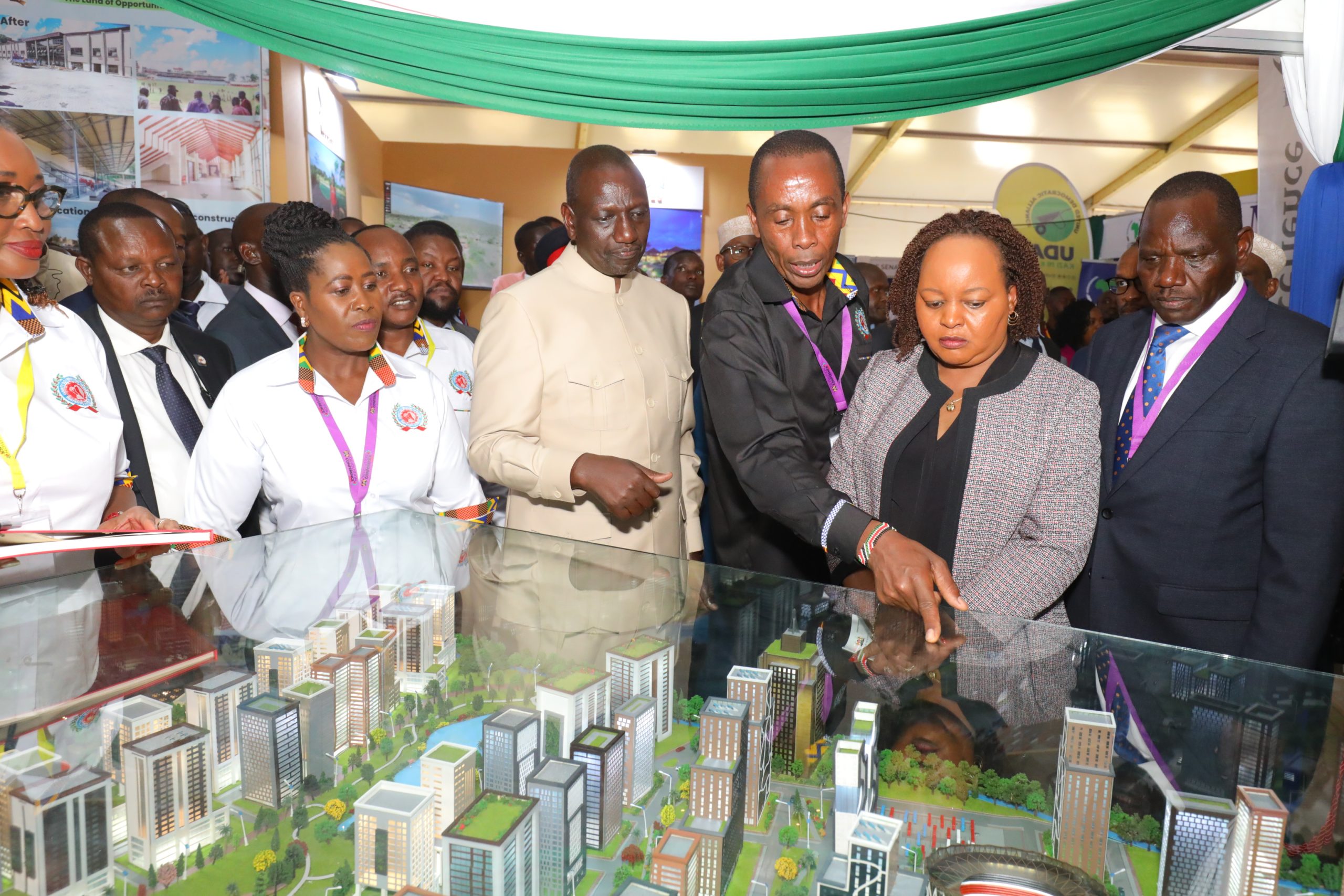 Kiambu Governor Kimani Wamatangi explains to President William Ruto and Kirinyaga Council of Governors’ chairperson Anne Waiguru about a model of the proposed Thika Industrial Smart City by Kiambu County, during the official opening of the 8th Annual Devolution Conference at Eldoret Sports Club in Uasin Gishu County, on August 16, 2023
Kiambu Governor Kimani Wamatangi explains to President William Ruto and Kirinyaga Council of Governors’ chairperson Anne Waiguru about a model of the proposed Thika Industrial Smart City by Kiambu County, during the official opening of the 8th Annual Devolution Conference at Eldoret Sports Club in Uasin Gishu County, on August 16, 2023
By Enock Maroa
Kiambu Governor Kimani Wamatangi has revamped his quest to make Thika the first City in Mt Kenya region by end of this year, which the governor says will generate 50, 000 job opportunities and spur economy.
The governor has reignited the process by establishing a fresh ad hoc committee to midwife the town’s elevation into an industrial smart city, and Mr Wamatangi said will culminate in President William Ruto conferring it with a charter.
Mr Wamatangi initiated the process last year but was forced to shelve it after a section of politicians, among them an elected leader in the Sub-County, sabotaged it by disrupting the public participation process in what was linked to selfish political interests.
The county chief gazetted representatives from the business community, Kenya Institute of Planners, Kenya Institute of Public Accountants, Kenya Institute of Architecture, Law Society of Kenya, Association of Urban Areas and Cities, and Kenya Institute of Planners as committee member.
According to the Friday Gazette notice, Ms Sylvia Kasanga will represent architects, Mr Gitu Kahengeri (lawyers), Mr Zachary Ng’ang’a (Urban Areas and Cities), Mr T.G Ndorongo (planners), Ms Jeanter Warigia (accountants), Mr Julius Macharia (Surveyors) and Ms Cecilia Mwangi to represent business community.
In the notice, the governor said the committee’s mandate will be “to consider and determine that Municipality of Thika meets the requisite criteria of classification as a city, advise and make recommendations for the conferment of City status to the Municipality of Thika.”
Thika whose location makes it the gateway to Mt Kenya, part Eastern and North Eastern regions, is considered one of the fastest-growing towns in Kenya due to the numerous industries, learning institutions which includes Mt Kenya University and Gretsa University, and well-laid transport and communication systems, which improved its economic growth and population to over 500, 000 people.
According to the Governor, once upgraded to a city, Thika will attract grants of approximately Sh1 billion per year for infrastructural development, including road tarmacking, drainage, street lighting, water connectivity, and a sewerage system, among other things.
“Upon attaining city status, Thika will experience substantial benefits, including infrastructural development, improved social standards, economic growth through the establishment of new businesses, increased property values, and economic empowerment via a 24-hour economy.
This elevation will enhance the County’s international visibility, opening doors for various opportunities and collaborations on the global stage. That is why I have set my sights on achieving this,” Mr Wamatangi said.
The governor said projects to give Thika befitting city status were in motion. These include the proposed dualling of a section of Thika-Garrisa road and increasing water capacity at Sh5.7 billion, which he successfully lobbied for during a meeting with the president on October 23, 2022, at the State House.
Also on the list is the Economic Processing Zone (EPZ), which has already been gazetted after Mr Wamatangi set aside 324 acres of the ceded Delmote Land, 25,000 affordable housing units, an international-standard stadium whose first phase is underway, markets and hospitals.
The County has also partnered with the Japan International Cooperation Agency (JICA) to manage waste better at the Kang’oki dumpsite that adopts inventive semi-aerobic landfill techniques.
Further, according to County Executive Committee Member of Housing, Planning, and Urban Development Salome Wainaina, the county upgrading the Kiandutu informal settlement, which has since been renamed Diaspora.
Ms Muthoni said the County had set aside Sh150 million for the infrastructure projects in the area, which include bitumen-standard roads, walkways, a social hall, drainage, high-mast floodlights, and 5,000 title deeds for residents living in the settlement.
Mr Martin Kagiri, the County Director of Municipal Partnerships and Coordination of Urban Areas, said data on social and physical infrastructure, revenue generation, land use, population, and development control have already been gathered, putting the process of making Thika a city at 60 per cent.
Following the committee’s creation, Mr Kangiri said, the county would begin public participation, write a report, and then draft a charter and an integrated development plan to be presented to the County Assembly for approval.
“Upon approval by the County Assembly, the report will be presented to the Senate for deliberation and adoption, with subsequent submission to President William Ruto for the designation of Thika town as a Smart City,” Mr Kagiri said.
Ends…..
New bus parks, improved infrastructure to bring new order in the transport sector
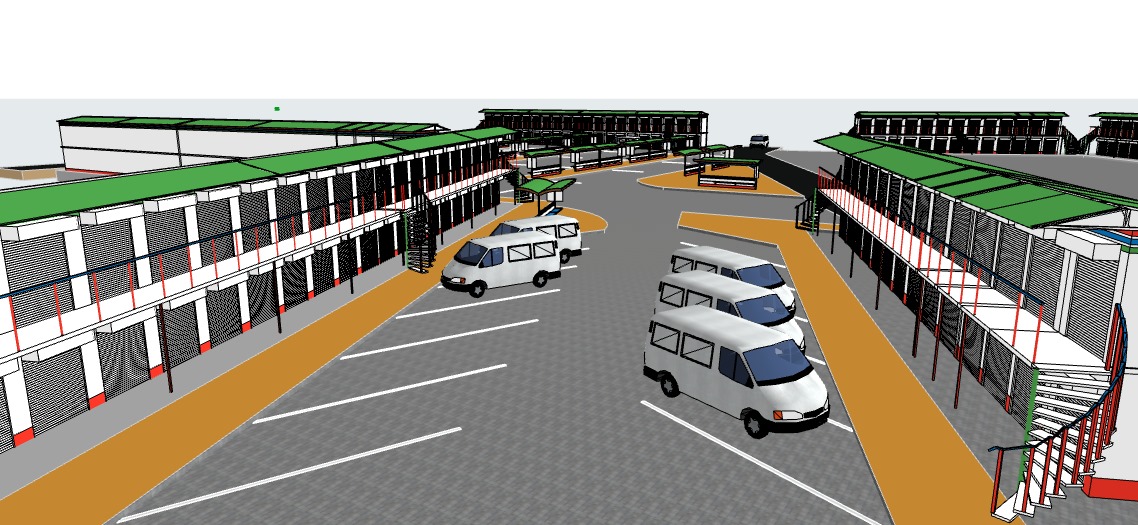 Artistic impression of all Kiambu bus parks under construction
Artistic impression of all Kiambu bus parks under construction
By MARION KANARI
The fast-growing number of people and urbanisation in Kiambu County is putting a lot of
pressure on the roads and transportation system. This has led to crowded streets,
disorderly transport services and dangers for everyone using the roads.
To address these challenges, the Department of Roads, Transport, Public Works and
Utilities is undertaking several initiatives. This includes the construction of 7 bus parks
and the rehabilitation of hundreds of kilometres of roads, complete with walkways and
storm water drains.
Progress updates indicate that upgrading to cabro construction is currently underway,
with Kiambu at 80 percent completion, Lower Kikuyu at 60 percent and Banana bus
parks at 10 percent. Additionally, engineers are in the process of designing Githiga,
Kwambira and Kwa Maiko Bus parks.
The proposed Kwambira bus park, located at the Total Petrol Station before the
Mutarakwa Junction, aims to alleviate passenger pick-up and drop-off along the Nairobi-
Nakuru highway, as well as attract Matatu Saccos to operate routes to Narok and
Suswa, ultimately relieving congestion at the main Limuru Bus Park.
Furthermore, the existing Githiga bus park, serving Matatus travelling to Kiambu,
Githunguri, Limuru and other areas, will be upgraded to cabro standards.
Nancy Wambugu, the Transport Director, emphasises that these efforts aim to
decongest urban areas and reduce travel distances for road users. “Matatu users from
Ngewa have to commute all the way to Githunguri to connect to Nairobi and Kiambu,
the bus park therefore will ease congestion and pressure at Githunguri Bus park and
ease mobility for Ngewa residents,” says Wambugu.
She adds that plans are underway to commence phase two of Makongeni Bus Park by
upgrading existing small scale trader’s shacks to modern kiosks after its tarmacking in
January 2014.
Ensuring inclusivity and safety for all road users, including the 12,267 registered Public
Service Vehicles within Kiambu County, the Directorate of Transport has activated the
County Transport and Safety Committee. This committee is tasked with developing
policies related to road safety, establishing safety standards for transportation modes,
and implementing public awareness campaigns.Inaugurating the committee, Acting CECM Wilfred Kiara stressed the importance of
regularising all public transport operations, especially with the increase in tuktuk
operators, to ensure the safety of road users.
“To improve interconnectivity, open up new roads in upcoming residential areas and
rehabilitate existing feeder roads the directorate of Roads has established a roads
maintenance unit, identified and excavated public quarries, using County equipment
and manpower to reduce cost of roads construction,” said the CECM. The unit in a bid
to cover the 4,300KM of County Roads Coverage has so far rehabilitated over 800
kilometres.
To support continuous economic growth, mobility and security for traders, motorists,
and the county at large, the Directorate of Utilities conducts routine maintenance and
servicing of street lights throughout the county.
Given the proximity and growth of Nairobi and other counties towards Kiambu, coupled
with its population of 2.4 million, urban population growth is inevitable. Hence, there's a
pressing need for comprehensive public infrastructure, increased security measures,
and urban connectivity.
The Department of Roads, Transport, Public Works and Utilities is committed to
improving the county's road network, ensuring the safety of road users, and meeting the
mobility needs of people and businesses. It aims to build upon existing planning
practices with a focus on integration, inclusivity and participation.
Farmers enjoy bumper harvest after receiving seeds, fertilizer
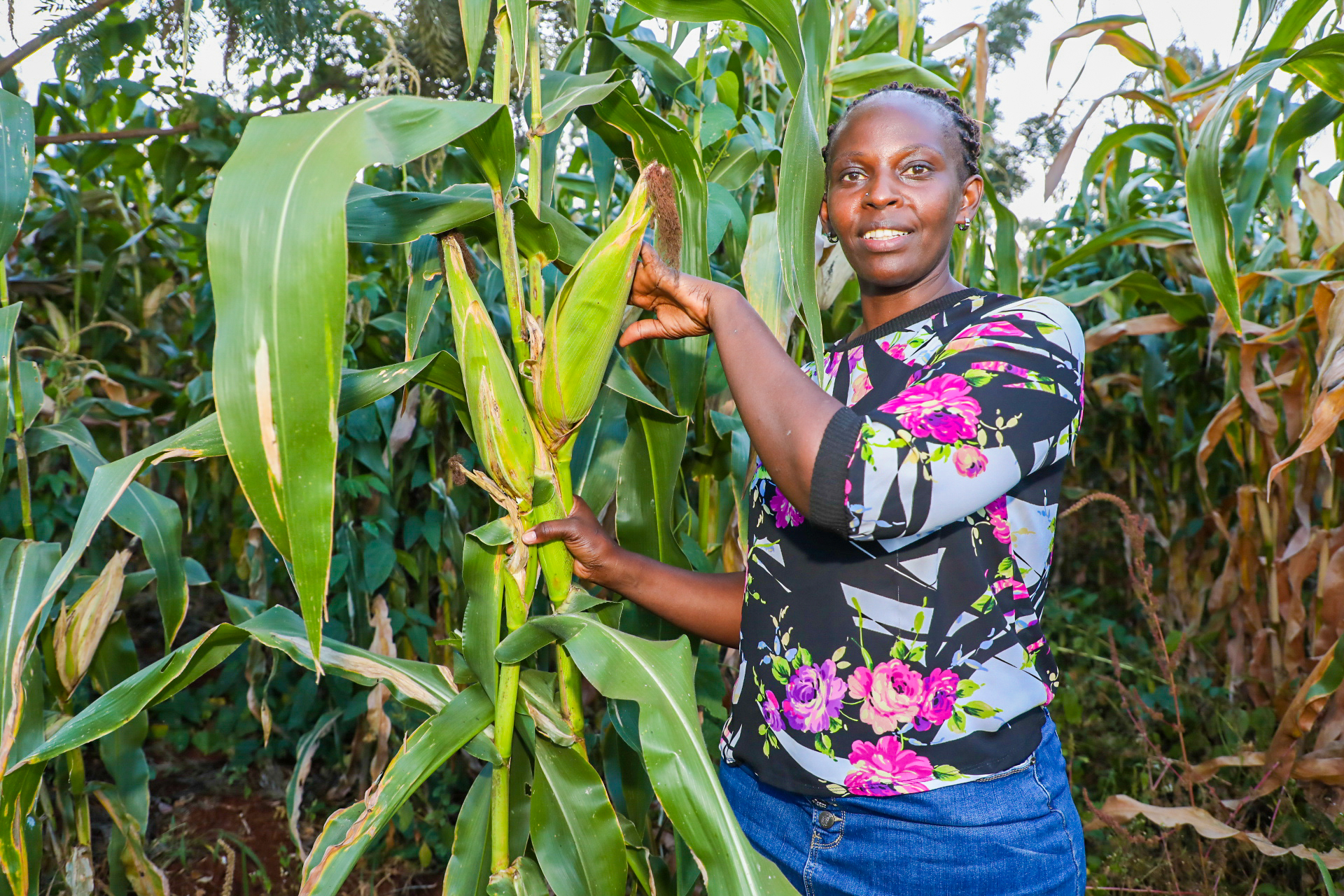 Margaret Wangari, a beneficiary of Kiambu County Government’s maize and seeds distribution programme.
Margaret Wangari, a beneficiary of Kiambu County Government’s maize and seeds distribution programme.
By OUR REPORTER
Farmers in Kiambu are enjoying a bumper harvest of maize from their farms
following the county government’s initiative, where they have been receiving
certified seeds and fertilizer.
The programme to give farms inputs is part of Governor Kimani Wamatangi’s
plan to tackle food insecurity and economic empowerment.
Most farmers are now harvesting maize, while for others; the crop is almost
maturing in farms.
The Governor has since last year been distributing free hybrid maize and crop
fertilizer to farmers across the county, and according to the County Executive
Committee Member for Agriculture Mwenda Kiara, over 300,000 farmers have
received farm inputs from the county administration.
“We have made deliberate intentions to ensure food security in the county by
providing farm inputs to farmers. Even in the coming season, we are prepared
to give inputs to over 60,000 farmers across the agricultural zones in our
county,” Mr Mwenda said.
Ms Esther Wariara from Githunguri Sub-County is one of the beneficiaries of
the free maize seeds and fertilizer from the county government of Kiambu.
She received the farm inputs in September of last year and planted them on
her farm, and now, she is harvesting the crop.
“Before we started getting the farm inputs, I struggled to access quality seeds,
which would affect the yield. Today, those people seeking maize flour in the
local shop are making minimal sales because almost everyone in the
community is harvesting maize from their farms,” she said.
Ms Margaret Wangari from Kwa Maiko in Ngewa Ward, in Githunguri Sub-
County, said the county government has been ensuring that before rains start,
farmers are always ready with seeds and fertilizer.
She is harvesting the crop she planted in September last year and already has
seeds for planting in the next season.
Mr David Wathika from Kihenjo village in Kaburu Ward, Lari Sub-County,
received the farm inputs in November last year and immediately planted on his
small farm.
He has also been receiving visits from extension officers from the county
government for advice on best farming practices. He expects to start
harvesting from next month.
Governor Wamatangi says the free farm inputs are meant to cushion the
farmers who, he said, incurred huge losses due to the prolonged drought that
hit the country between 2020 and early to mid-2023, which left many people
grappling with hunger.
President William Ruto has lauded farmers in Kiambu, saying that after a
prolonged severe food shortage, the country was on a recovery trajectory, and
Kiambu County had emerged among the top food producers.
Wamatangi’s early morning strategy that brought positive change in Kiambu
 Governor Kimani Wamatangi presiding over a management meeting at his office. The meetings happen everyday from 6:30 am. Photo: Ayub Muiyuro
Governor Kimani Wamatangi presiding over a management meeting at his office. The meetings happen everyday from 6:30 am. Photo: Ayub Muiyuro
‘The Kiambu Report’ writer
Every day, at the crack of dawn, Governor Kimani Wamatangi is already seated in his office,
prepared to address the needs of his people. Since taking office, the Governor has not only made it a habit but a rule to be at his desk by 5 am.
This new approach has been embraced by the county government’s management, instilling a culture
of early office attendance to strategise for the day ahead. This shift in mindset has led to the
implementation of daily management meetings among top county officials. These sessions focus on
thoughtful discussions and planning to devise effective strategies for “Making Kiambu Great Again.”
In contrast to other government offices where officials typically arrive after 8 am merely to hang their coats before leaving, the Kiambu County Government maintains a strict routine.
Here, all top county officials are required to participate in a daily management meeting within the Governor’s office, spanning from 6:30 am to 9 am. This session serves the purpose of planning and discussing the government’s agenda, aligning it with the governor’s manifesto and addressing the people’s priorities.
Governor Wamatangi presides over the meeting, while the County Secretary’s office records the
minutes. Additionally, the governor personally takes notes for follow-up and action.
The meeting involves each department presenting their respective work plans, action points and
timelines. Progress on previously presented projects and programs is reported, with CECMs or chief officers delivering PowerPoint presentations on a large screen mounted on the wall.
Governor Wamatangi actively contributes to the meeting, offering input that includes adjustments,
corrections, and guidance to ensure precision in the execution of plans.
Unlike many other organisations where heads of institutions tend to adopt a one-man-show
approach, Governor Wamatangi emphasises a style that fosters collective responsibility in running
the county.
According to him, this approach not only enhances transparency and accountability but also ensures that all departmental heads openly share their plans. Moreover, it contributes to increased effectiveness and efficiency.
“The meetings help us understand our position in terms of project plans and execution in each
department. They prevent us from working in silos. Everyone comprehends the activities of each
department and when a program spans multiple departments, they collaborate in its implementation, avoiding a one-man-show approach,” notes Mr. Wamatangi.
The planning department is mandated to have the budget ready and the governor has issued a
directive that all call tenders must be paid within 14 days or a maximum of 30 days upon delivery
and completion.
Individuals who have previously worked with Wamatangi, whether in his private businesses or
during his Senate tenure, attest that early morning planning meetings are his modus operandi.
They describe him as a hands-on leader who values tidiness and dedication in all his endeavours.
Wamatangi expects the management team to emulate his approach and instil the culture he has
introduced in their subordinates.
In a marked departure from the previous regime, where offices were dilapidated with an unkempt
compound, the county offices today undergo regular renovation and are freshly painted. The
premises feature a lush green lawn that receives daily watering, reflecting a commitment to
maintaining a conducive and aesthetically pleasing work environment.
Mr. James Njuguna, the Chief of Staff, emphasises the importance of the meetings in monitoring the implementation of county projects. In certain instances, departments are required to provide daily updates on specific projects. \According to Njuguna, the primary objective of these meetings is to foster a sense of collective responsibility among the leadership regarding the county’s management.
He explains: “The meetings provide a platform for leadership to engage in discussions. Members
collaborate to enhance proposals, departments offer mutual support, and the governor assumes the
role of monitoring, evaluating, and guiding progress based on the action points.
The action points are aligned with the timelines set by each department.”
This approach ensures that every CECM and chief officer is familiar with the programs of other
departments. They are directed to support one another, preventing any department from falling
behind and ensuring effective service delivery.
Osman Korar, the CEC for Youth, Sports and Communication, highlights the benefit of discussing
programs in other departments during these meetings. He notes: “When making presentations, the
governor and the rest of the team provide constructive feedback to enrich ideas or introduce new
perspectives. It exemplifies teamwork as we collectively strive to enhance Kiambu.”
Boost as hospitals get state-of-the-art medical equipment
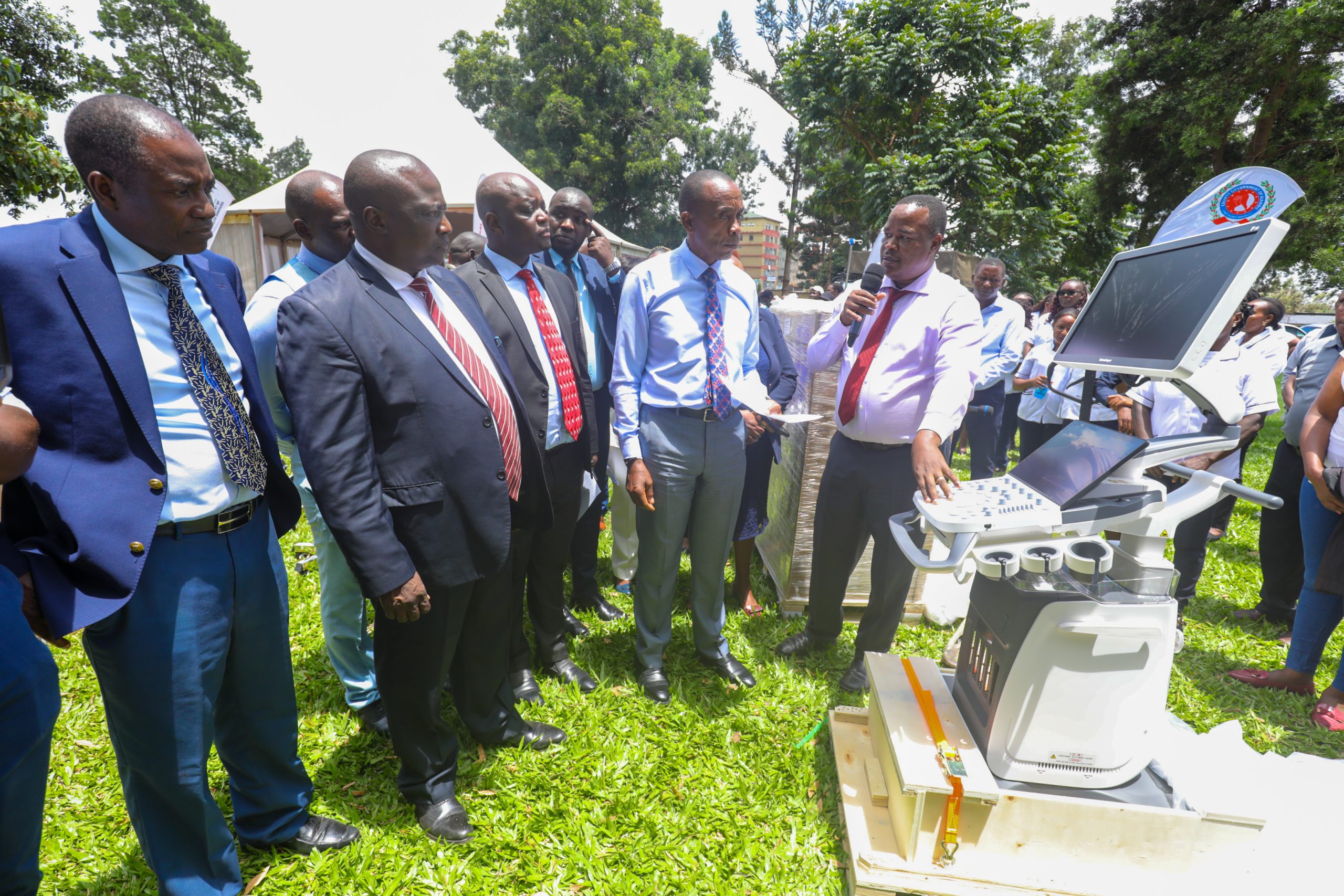
Kiambu County Health Services Chief Officer Dr Patrick Nyagah (right) explains to Governor Kimani Wamatangi (second right) and other county leaders and county officials about a new Ultrasound machine, which is part of an assortment of specialized medical equipment that was delivered to the county on March 5, 2024. PHOTO AYUB MUIYURO
By KELVIN KIMARU
The County Government has procured an assortment of specialised medical
equipment worth approximately Sh500 million, which will be installed in various
health facilities across the county.
The various equipment received by Governor Kimani Wamatangi at the County
Headquarters were flagged off to their final destinations.
According to the county chief, the equipment are meant to enhance the delivery of
services in all cadres of health facilities in the County.
They include digital X-ray machines, digital ultrasound machines, patient monitors,
BGA machines, , infusion pumps, nebulizers, oxygen concentrators, oxygen flow
meters, suction machines, and dental X-ray machines.
Others are Sonic Aid foetal scopes, pulse oximeters, emergency stretchers, gauze
cutters, portable examination lights, wheelchairs, delivery beds, hydraulic mortuary
trolleys, portable drip stands, and HBC machines.
According to the Department of Health Services, the X-ray machines will be
delivered to Thika, Gatundu, Kihara, Karuri, and Igegania hospitals to boost
capacity, while the modern ultrasound machines are for Gatundu, Kihara, Ruiru,
Nyathuna, and Karuri hospitals.
Governor Wamatangi said the consignment was part of a work-plan development of
his administration to equip all the facilities after a need assessment informed the
gaps in hospitals which are now being filled.
“We have always had an issue with our hospitals, whereby `most of them did not
have the equipment, or the existing ones were kept breaking down; this really
hampered our service delivery, but with what we now have, we will improve on our
services, and we still have more consignment coming. We are equipment to our level
three hospitals. We have also planned how we will equip the new hospitals
that we are building,”; Governor Wamatangi said.
According to the Governor, the additional equipment also includes C-T Scan
machines and assorted equipment for laboratories and theatres that will be installed
in level four and level five facilities.
Two weeks ago, the County commissioned state-of-the-art X-ray and ultrasound
machines to revamp CT-scan services at Gatundu Level 5 Hospital, with the governor
saying by delivering the equipment, he aims to ensure swift and accurate medical
assessments within the facility and to reinforce our pledge to prioritize the well-being
of our people.
The County Executive Committee Member in charge of Health, Dr. Elias Maina, said
ofthe delivered equipment Gatundu Hospital would also receive 12 patient monitors,
eight infusion pumps, BGA machines, wheelchairs, nebulizers, and gauze cutters. At
the same time, Igenania Hospital will be equipped with an X-ray machine, portable
drip stands, oxygen flow meters, gauze cutters, and dental X-ray machines.
Casualty departments of Kiambu, Thika, Gatundu, Ruiru, Tigoni, and Kihara
hospitals will receive wheelchairs for patients in emergencies.
Other hospitals that receive a medical equipment catalogue include Kiambu, Thika,
Ruiru, Lari, Tigoni, Nyathuna, and Wangige, while Githunguri, which is a new level four hospital under construction, is expected to receive equipment worth Sh300
million through a partnership between the national and county governments.
The County has also completed a drugstore in Ruiru to be used as a central medical
facility where all of its supply orders for pharmaceuticals and non-pharmaceuticals
will be housed before being dispersed to the 114 hospitals throughout the County.
Dr. Esther Kamau, the County Head of the Health Technologies and Products Unit,
said the facility would enable the County to refill pharmaceuticals to all facilities on
time by eradicating delays caused by procurement bottlenecks.
The County is actively working towards integrating all level two and three facilities
into the NHIF system to streamline healthcare services and ensure that registered
residents can avail themselves of medical assistance free of charge.
This, Mr Wamatangi said, will ensure that patients who visit all the County’s 114
health facilities get outpatient and outpatient services for free as long as they are
registered with NHIF, which President William Ruto changed to Social Health
Insurance Fund as part of his health reforms.
KIAMBU’S EDUCATION REVOLUTIUON
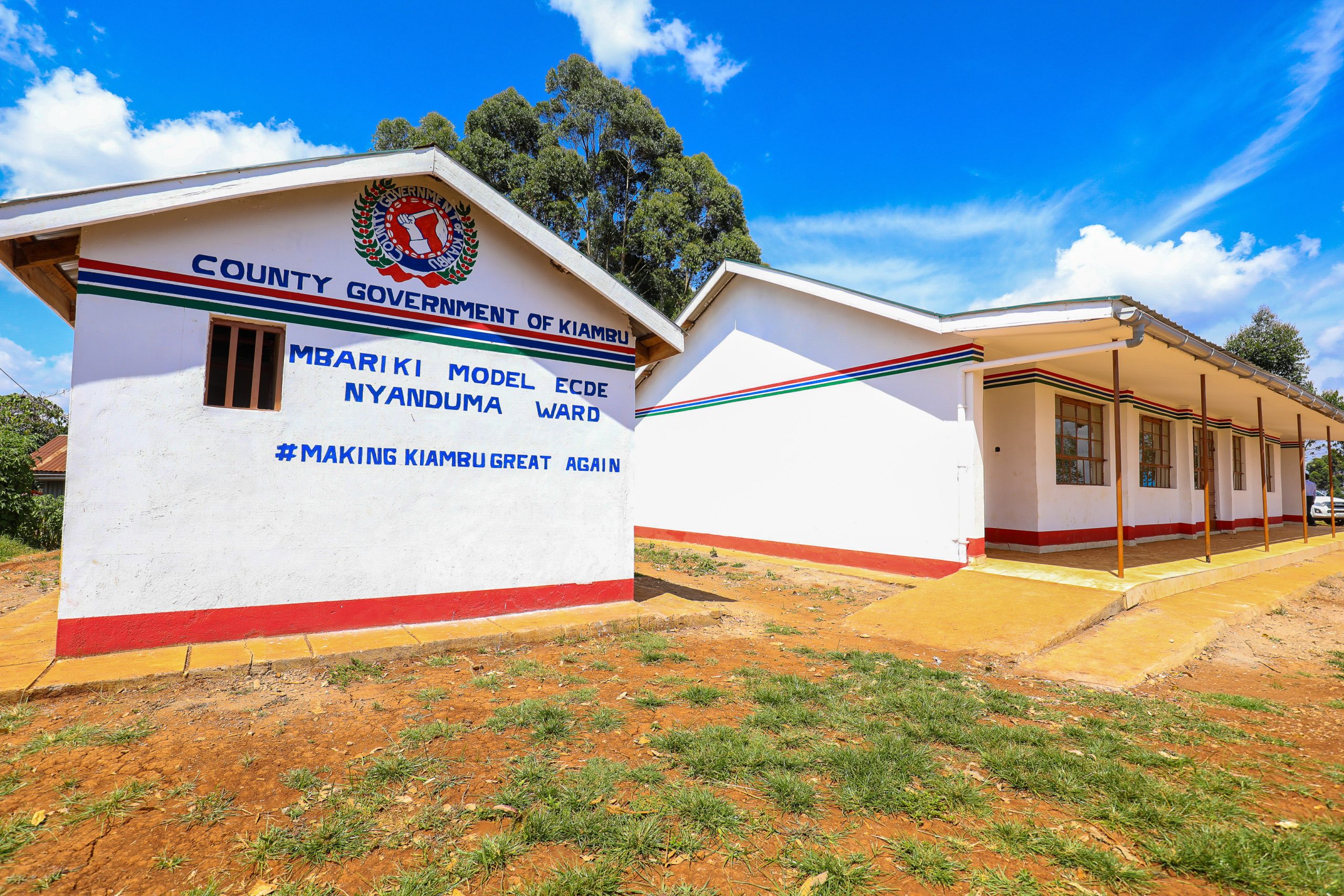
BY ANN WANJIKU
Governor Kimani Wamatangi’s administration has embarked on an ambitious program to transform the education sector in the county to enhance access to quality education and improve education standards.
From construction of new model ECDE centres, a feeding program where nursery school pupils enjoy nutritious uji, boiled eggs and fresh milk, increased bursary to revamping Vocational Training Centres (VTC), Kiambu is witnessing a revolution in the education sector as Wamatangi works to fulfill his “Leave No Child Behind” campaign pledge.
Since devolution in 2013, nearly all the county-owned 524 ECDE centres that should serve as children’s foundation and education bedrock have been run-down shacks with earth floors, collapsing rusty roofs, and crumbling walls with gaping holes.
However, Wamatangi is rewriting history by modernizing the ECDE centres by constructing new structures with facilities available in private kindergartens.
The County, through the Department of Education, Gender, Culture and Social Services, is currently working on 180 ECDE centres in various implementation stages, with Governor Wamatangi setting a deadline of 2026 for the completion of the modernization of all 524 ECDE centres.
“First impressions are important because they shape a person’s attitude or behavior towards something. Imagine if the children’s first exposure to schooling is in the dreadful condition of public nursery schools; how do we expect them to love learning?” Mr Wamatangi posed.
He added: “Currently, we are constructing 130 Early Childhood Education Centers (ECDE) that will be identical and will be completed in December as the first phase of a comprehensive effort to guarantee that all 524 public nursery schools are modernized in the next three years.”
Margaret Muthoni, the chief instructor at Mbariki ECDE centre in Nyanduma Ward, Lari County, which is one of the centres that have been transformed from a wooden ramshackle.
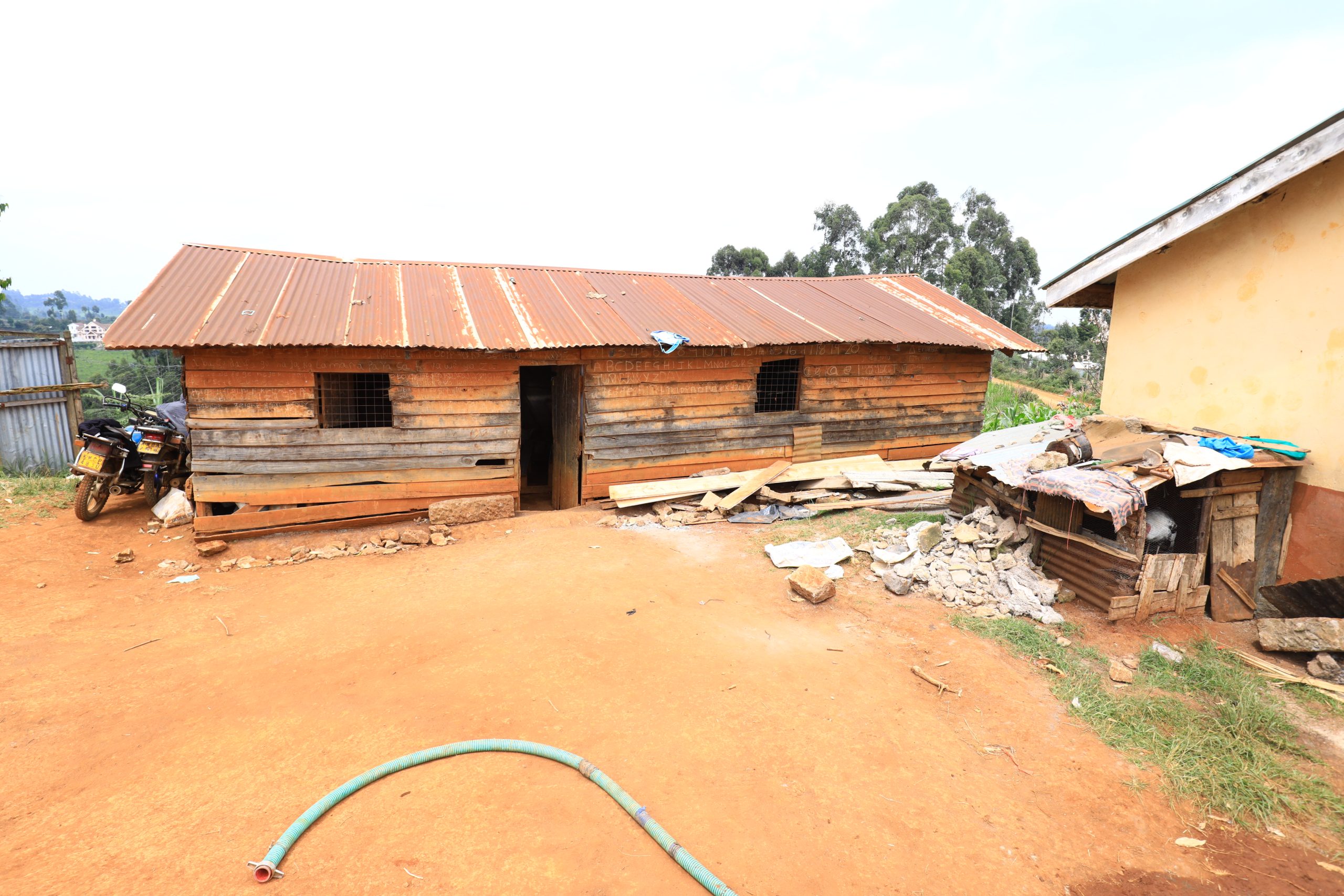
“The school’s walls were collapsing, and the floor was a mess. The general state of hygiene was very poor. Therefore, whenever we admitted kids for PPI, their parents would transfer them in the second term, blaming the schools’ bad conditions,” Muthoni said.
Muthoni said the number of pupils was consistently under 20 and that it had only recently begun to increase after the County introduced a feeding program for all 36 254 kids.
The County provides a stock of porridge flour and treys of eggs, and arrangements have been established for the centre’s administration to make the meals.
Porridge is offered daily, and eggs are also offered on Mondays, Wednesdays, and Fridays, and starting on March 14, 2024, the children began getting a packet of milk once a week.

The County Executive Committee Member in charge of the department, Ms Nancy Gichung’wa, says the program aims to increase enrollment and keep kids in schools, which most have been skipping due to a lack of food.
Further, to ensure that needy students do not miss lessons in high school, colleges and universities, the County increased the annual bursary kitty from Sh100 million, which was being disbursed from 2013 to 2022.
In 2023, Governor Wamatangi tripled the kitty to Sh300 million, allocated to 72,000 students in just one year.
This year, the County has increased the amount to Sh500 million, with the governor indicating that the minimum allocation per student will be Sh5,000 for Day School Students and Sh10,000 for Boarding School students.
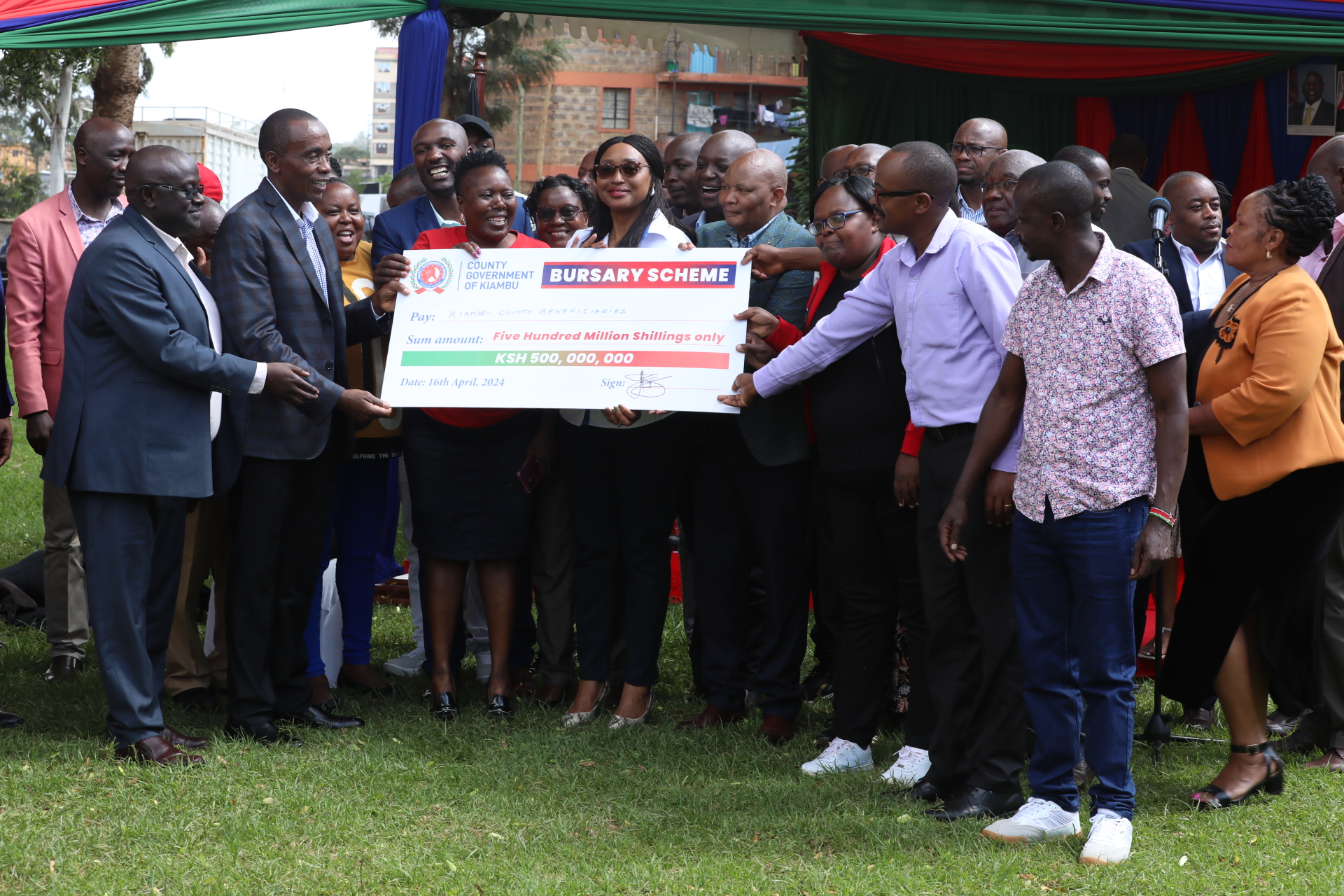 To ensure that young people get opportunities to acquire technical skills, the County is currently constructing and renovating more than 10 Vocational Training Centres (VTCs) across the County.
To ensure that young people get opportunities to acquire technical skills, the County is currently constructing and renovating more than 10 Vocational Training Centres (VTCs) across the County.
According to Ms Emily Nkoroi, the acting chief officer in charge of Vocational Training and Social Services, the devolved unit is increasing the capacity of the 39 VTCs in the County by installing the necessary machines and equipment to ensure they can train the youth in various skills.
As part of a planned beautification and enhancement of towns in the County, the regional government is installing cabro-making machines in selected VTCs to supply the paving stones. The youth will make cabro stones and install them on streets and walkways.
\
Ends….
Turning tides of hospitals ‘white elephant’ projects in Kiambu
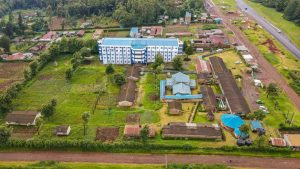
Lari Level Four Hospital
By Kevin Kimaru
Infrastructure in healthcare is a pillar that significantly impacts the quality and accessibility of
healthcare services. Robust hospital facilities, well-equipped clinics and efficient equipment
maintenance are not just investments; they are fundamental components of a thriving healthcare
system.
Governor Kimani Wamatangi’s administration, under the ‘Wealth Through Health’ vision, has
exemplified this understanding by prioritising the revival and expansion of healthcare infrastructure across the county.
Upon assuming office, Governor Wamatangi was confronted with a dire need to address the inadequate hospital infrastructure in the county.
Numerous hospitals had languished, labelled as costly white elephants that drained public funds
without delivering the intended services.
In response, he swiftly moved to revive critical facilities such as Githunguri, Thogoto, Lari, Wangige, Bibirioni and Tigoni hospitals, injecting new life into these essential healthcare hubs. His focus has been on revitalising existing hospitals and strategically
constructing new facilities to bridge gaps in healthcare access. These efforts ensure that every
citizen has equitable access to quality healthcare services.
According to the CECM Health Services Dr. Elias Maina, the County is not just looking at the stalled
projects; “we are electing 13 new level 3 facilities and building two more level four facilities.
This will ensure that we are constructing facilities within a radius of 5 kilometres.”
On the other hand, Dr. Patrick Nyaga, Chief Officer of Health Services, the County Government
launched over Sh1.5 billion in health projects since Governor Wamatangi’s tenure began.
Our approach encompasses completing stalled projects, building new facilities and undertaking extensive
renovations to modernise existing infrastructure. This holistic strategy is essential for delivering
sustainable healthcare solutions.”
Additionally, there has been significant the department has also moved to maintain equipment and facilities to deliver effective healthcare outcomes. Our goal is to create a seamless experience for both healthcare providers and patients by ensuring that equipment is modern, functional and
regularly maintained.
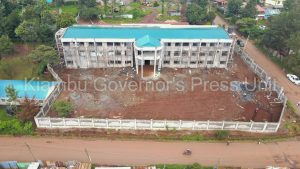
Thogoto Level Four Hospital
The comprehensive efforts by Governor Wamatangi’s administration underscore a strategic vision to transform healthcare accessibility and quality across the county.
By addressing the longstanding challenges of hospital infrastructure, the county is enhancing health outcomes and safeguarding public resources through efficient project
management and maintenance practices. Investing in healthcare infrastructure goes beyond mere
construction—it is an investment in the well-being and prosperity of the County. Governor
Wamatangi’s approach exemplifies a commitment to realising the vision of ‘Wealth Through Health’ by harnessing the transformative power of robust healthcare infrastructure.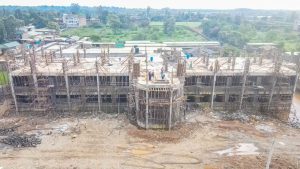
New Juja Level Four Hospital
How the sports and youth pillars are progressing in Wamatangi’s plan
By Duncan Ojijo
Governor Kimani Wamatangi has been committed to empowering the youth and harnessing talent
through sports, fulfilling the pledge he made in his election manifesto.
He has placed special emphasis on both talent development and infrastructural improvements in sporting facilities.
Given that the youth form the majority of Kiambu’s population, Governor Wamatangi has made it a priority to focus on this segment of society.
The Department of Youth Affairs and Sports has actively engaged in programs aimed at empowering young people and nurturing their talents.
In a bid to boost the sports sector and provide state-of-the-art facilities for athletes, the County, has embarked on an extensive mission to revamp sports facilities to international standards across the county.
This ambitious initiative aims to enhance the quality of sporting events by fostering a vibrant sporting culture within the community.
“We are committed to providing world-class facilities to nurture and empower our talented sportsmen and women in Kiambu County,” said Ali Osman, CEC Member for Youth Affairs, Sports and Communication.
“These upgrades have been tailor-made to benefit athletes while still providing
recreational spaces for the entire community.”
One of the flagship projects currently underway is the transformation of Kanjeru Stadium in Gitaru Ward. Upon completion, the stadium will boast two football fields – one dedicated for training and the main field equipped with a standard running track, spectator stands, two tennis courts, and a basketball court.
This multifaceted project has been designed to accommodate a diverse range of sporting
activities and cater to the needs of both athletes and spectators alike.
Similarly, Thika Stadium has undergone significant transformation. Closed to the public since January 2024 to expedite renovations, the stadium is receiving a two-phase upgrade.
Phase one focuses on practical improvements, including completing the stalled spectator stands to increase seating capacity, leveling the pitch, and constructing 100 business stalls for local traders.
Phase two will introduce exciting new features like a modern athletics track, a swimming pool, a gymnasium, and an additional 200 stalls
around the stadium perimeter.
The initiative extends beyond major stadiums with Kagwe Stadium in Nyanduma ward, Lari Sub-county, currently undergoing leveling, compacting, and fencing works to improve its facilities. Similarly, Kirangari Polytechnic in Nyathuna ward is witnessing significant progress in its leveling and compacting endeavors, signaling a promising future for sports supporters in the area.
The Department has also already awarded tenders for upcoming upgrades at Ruiru Stadium, Gikambura Super 99 Grounds in Kikuyu, and Githunguri Stadium.
The Department hasn’t overlooked smaller fields either as several facilities have already been leveled and compacted, including Theta Ground in Juja Sub-county, Stage 46 Ground in Mwohoko- Ruiru Sub- county, SP Ground in Malaba Witeithie Ward- Juja Sub-county, Kamirithu Primary School Grounds in Ruiru Sub-county, Kiambu Primary and Kamunyonge Grounds in Kiambu Sub-county, and a volleyball court in Limuru Stadium among others.
This county-wide effort signifies a strong commitment to nurturing a vibrant sporting culture in Kiambu.
With these upgraded facilities, residents can expect a significant boost in athletic opportunities and community recreation.
Kiambu leading in implementing the Bottom Up economic philosophy
By Njeri Karu
In line with the Bottom-Up Transformation Agenda (BETA) that propelled the Kenya Kwanza
administration to power, Governor Kimani Wamatangi has been at the forefront of implementing the
Plan, which mirrors his manifesto.
His administration has been deliberate in rolling out projects as outlined in his manifesto to support the hustlers at the bottom of the pyramid.
On this front, the Governor and his team have been busy on the ground, implementing programs
beneficial to ‘Mama Mboga’, Bodaboda operators and other small-scale traders.
His administration is behind the market designs models adopted by the State Department for Trade in constructing markets across the country.
In Kiambu, Governor Wamatangi has set the ball rolling by initiating the construction of seven mega markets as well as the rehabilitation and renovation of the existing markets.
In his manifesto, the Governor identified the ‘hustlers’ as his top priority, ensuring they have decent
places to conduct their businesses. His administration has been focused on market projects, which are central to supporting ‘Mama Mbogas’.
Construction is currently underway for two Esp markets: Soko Mjinga market in Lari Sub-county and Tin’gan’ga market in Kiambu Sub-county.
These markets are strategically located with access roads on all sides. Plans to start Ngewa market, Gitwe market, Gikuni market, Gatukuyu market, and Kiandutu market are progressing rapidly.
“The construction of these markets will not only help traders make a living but also boost the economic growth of the county,” said Mburu Kang’ethe, CECM Trade, Industrialization, Tourism and Investments during the groundbreaking ceremony of the Gitwe modern market in Gatundu South Sub-county.
Two additional dome shades have been built at Rironi and Kiganjo markets, drainage systems, solar
lighting, floodlights and waste cube containers for garbage have been placed in these markets.
“We will renovate existing markets and construct modern ones to improve the trading environment and reduce congestion,” says Chief Officer of Trade Mr. Simon Kiberenge.
Governor Wamatangi has also prioritised constructing bodaboda sheds for motorcyclists, providing
them with a conducive environment for their business. Their operations have also been improved with the rehabilitation of rural access roads across the county.
In addition, plan to establish a County Aggregation Industrialisation Park at Waruhiu farm in Githunguri Sub County are already in the pipeline.
The project, which is in line with the Bottom Up Economic
Transformation Agenda is a partnership between the state department of Housing and the Council of
Governors (COG)will see each county allocate Sh250 million towards this initiate which will be matched with a similar amount from the national government. The park will serve as hub for agricultural
processing and manufacturing, providing a link between farmers, industries and the markets. Farmers will also get the opportunity to learn about various aspects of agriculture and agribusiness from different Agri professionals and companies.
The site has been handed over to the contractor awaiting launch as completion of the feasibility study of this project nears and value chains identified.
In the Directorate of Tourism, substantial work has been carried out as Kiambu moves to tap its
potential in the sector.
The focus is on mapping out, developing and leveraging Kiambu’s tourist sites while addressing barriers preventing the sector from thriving. Plans are in place to enhance cultural centres, rehabilitate existing tourist sites and develop more eco-tourism destinations.
Last month, Tourism and Wildlife Cabinet Secretary Dr. Alfred Mutua, accompanied by Tourism PS John Ololtuaa, paid Governor Wamatangi a courtesy call to discuss this important issue.
The CS pledged to collaborate closely with the county’s tourism directorate, including strategic
marketing of Kiambu’s tourist circuits.CS Mutua also promised to consult with the Ministry of
Environment to address environmental concerns, such as severe water pollution at 14 Falls, a once- thriving tourist spot, and modernising other attraction sites in the county.
Kiambu County boasts a rich array of tourism offerings, with over 70 attraction sites. These include resorts, agro-tourism experiences like exploring tea and coffee farms at sites such as Fairview Coffee Estate in Kiambu town and Kiambethu Tea Farm in Limuru and cultural tourism with historical attractions like Kimunyu Maumau Caves in Gatundu, Mugumo Gardens in Thika and Turi a Mumbi Cultural and Heritage Centre in Tigoni.
Eco-tourism options include the Forest Adventure Centre in Limuru, known for activities such as zip lining, archery, mountain biking and nature walks, as well as natural wonders like Fourteen Falls in Thika, Paradise Lost Amusement Park in Kiambu, and Kijabe Hot Springs, offering hiking and exploration of underground tunnels and caves.
‘Maji Nyumbani’ initiative on track as Wamatangi’s plan unfolds
By Esther Kihanya
In the midst of jubilations and singing in the village of Komothai ward, a symbol of progress arrives: two massive 10,000-litre water tanks, delivered by the Department of Water and Sanitation.
For the residents, this delivery is not just about water; it is about a promise fulfilled.
“Today I would like to say I will have water in my house thanks to the governor, may he continue
doing what he promised the people,” Mary Kamau from Komothai Ward expresses her gratitude.
This scene sums up the essence of Governor Kimani Wamatangi’s campaign promise—to transform
Kiambu and ensure that every household has access to clean, piped water through his ‘Maji
Nyumbani’ initiative.
But has he kept his word?
Under Governor Wamatangi’s leadership, Kiambu County has witnessed substantial investments in
water infrastructure. Over 150 kilometres of network pipes and more than 60 water tanks have been
procured and delivered, facilitating more than 10,000 water connections to serve over 15,000
households.
“The governor’s vision is not to leave any person behind in water accessibility,” emphasises CECM David Kuria.
He noted that over 20 boreholes will be drilled in the next few months.
The impact of these initiatives is palpable. John Njoroge, a resident of Gathanji, recounts how he no
longer needs to buy water from neighbours since being connected to Githunguri water. “I used to
buy water at my neighbour’s shallow well, but now I am glad I can open my tap and drink my own
clean water,” he says.
Moreover, the government’s commitment extends beyond immediate solutions. Governor
Wamatangi’s administration is drilling boreholes across every sub-county, with over five boreholes
already operational and more in the pipeline.
“The department is currently procuring more pipes to be distributed to water companies,” says
Jennifer Kasyoki, the Chief officer in the Department.
But the governor’s ambitions don’t stop there. In recent weeks, he has launched boreholes in various
sub-counties, including Lari DDC, Njiku in Kiambaa, and Gatuanabu in Kabete, aiming to connect
even more residents to clean water.
Furthermore, in collaboration with the national government, Governor Wamatangi has secured
funding to expand the capacity of the Karemenu Dam—an investment of Kshs 5.7 billion that will
benefit not only Kiambu but also neighbouring areas like Ruiru, Juja and Thika, addressing long-
standing water shortages in the region.
However, the journey towards comprehensive development involves addressing not just water
accessibility but also sanitation and waste management. As urbanisation increases, so does the need for effective waste management infrastructure.
Recognising this, the county government is committed to expanding sanitation and waste
management facilities in all urban and peri-urban areas, a crucial step as Thika aims to transition into a city.
Governor Wamatangi’s efforts to fulfil his promises of transforming Kiambu and ensuring water
accessibility have yielded tangible results.
From infrastructure investments to borehole drilling and securing funding for dam expansion, his
administration has demonstrated a steadfast commitment to improving the lives of Kiambu
residents.
Investing in education and welfare: Kiambu County’s bold initiatives
In a move aimed at boosting education and uplifting the community, Kiambu County has launched a
bursary kitty, now standing at Kshs 500 million for 2024 academic year a significant increase from the previous Kshs 300 million.
This aims at giving a minimum allocation of Kshs 5,000 to learners in day schools and Kshs 10,000 to those in boarding schools.
This increase in funding reflects the County Government’s commitment to providing educational
opportunities for its residents, especially the underprivileged under the Governor Kimani
Wamatangi’s “Leave No Child Behind” clarion call.
Another key pillar of education initiative is the construction of Early Childhood Development
Education (ECDE) centres and Vocational Training Centres (VTCs) across the county which are on
various levels of completion. These centres are poised to serve as hubs of learning excellence,
equipping learners with essential skills and knowledge to thrive in an ever-evolving world.
Moreover, Kiambu County is not just focusing on academic pursuits but also on addressing the basic needs of its people. Through targeted welfare programmes, the county is ensuring that no one is left behind from distributing food to the less fortunate to providing sanitary towels to needy girls, the county government is actively working to alleviate poverty and promote dignity among its residents.
According to the acting Chief Officer in charge of Vocational Training and Social Services Ms Emily Nkoroi, apart from constructing new VTCs and expanding the existing ones to ensure there’s a centre of excellence in every Sub County, the department is also providing the VTCs with qualified instructors.
“Social interventions like increase in bursaries and support to the needy by giving them foodstuff, diapers, blankets for the elderly and capacity building through gender intervention aims at ensuring equal inclusivity,” Nkoroi says.
In a bid to honour the boy child and recognise the invaluable role they play in the society, the
department organised a Boy Child’s Day, which was graced by Governor Wamatangi, Deputy
Governor Rosemary Kirika and a special attendance by Tourism and Wildlife Cabinet Secretary Dr.
Alfred Mutua.
Steve Muriuki expressed his gratitude to Governor Wamatangi’s administration for remembering the
long forgotten boy child.
“A lot of emphasis has been put on the girl child that the boy child’s efforts are no longer recognised neither are his needs met. However we now see light at the end of the tunnel and we are grateful that we have full support from our Governor and we are positive that things will be different,” he said.
In light of promotion of culture and heritage, gazettement of Mugo wa Kibiru grounds in Thika’s
section 9 followed by fencing and beautification is in the process.
This holistic approach to development exemplifies Kiambu County’s vision of creating a vibrant and inclusive society where every individual has the opportunity to succeed. By investing in education and social welfare, the county is laying the foundation for a brighter and more prosperous future for generations to come.
During the 2022 elections, Governor Dr. Kimani Wamatangi campaigned on a platform of change,
“Making Kiambu Great Again.” His mantra of a new administration and a new direction resonated
well with the public.
He rolled out his manifesto based on a number of core values that he believed would propel the county to greater heights. He expressed his desire for Kiambu to lead in prosperity
and wealth creation.
And the governor has fulfilled his part of the bargain.
Under the pillar of “Hudumia wanaKiambu,” the Governor initiated a culture change to ensure the
prudent management of public resources. He introduced a dome tent, affectionately nicknamed
Naivasha, which now serves as the venue for County Government officials; meetings.
The Governor proposed this tent as a cost-cutting measure to reduce escalating recurrent expenditure, avoiding unnecessary expenses associated with hosting county functions in hotels and other luxurious venues.
A report by the Controller of Budget, Dr. Margaret Nyakango, on the status of budget
implementation by counties, returned a favourable verdict on Governor Wamatangi due to the
austerity measures he introduced.
The County Government of Kiambu is in the final stages of introducing a game-changing digital
program.
The platform is a sophisticated and integrated technological application in the form of an Enterprise Resource Planning (ERP) system.
Its goal is to digitize all government programs into a singular system, aiming to automate government services and improve revenue collection in the county.
This program is one of the five key pillars of Governor Wamatangi’s Manifesto for 2022-
2027, falling under the Governance Pillar, which aims to transform Kiambu County’s governance
system by instilling integrity, accountability, and transparency in service delivery.
The ERP system is holistic, covering financial management in all sectors such as hospital
management, building approvals, business permits, and other revenue charges while also exploring
additional revenue streams.
It includes a digital platform ensuring integrated data management,
such as human resources, fleet, biometric staff identification, e-cabinet, service delivery portal, among others. This comprehensive approach enhances efficiency and effectiveness, improving overall productivity within the government.
As part of the ‘Hudumia WanaKiambu’ action plan, Governor Wamatangi assented to the Kiambu
County Revenue Bill on December 7, 2023, after it received unanimous approval from the County
Assembly of Kiambu.
This Act establishes the Kiambu Revenue Authority, providing for the general
administration, collection of levies and fees, and enforcement of regulations related to revenue by the County Government of Kiambu. The law aims, among other things, to professionalize Own
Source Revenue collection, ensuring a service-centered approach without harassing or exploiting
traders.
The Governor promised to ensure that every eligible child is enrolled for ECDE and will prioritise th provision and upgrade of all the requisite facilities, teachers, and financial support to achieve a 100% enrolment rate within the first year in office.
The Kiambu “Leave No Child Behind” initiative aims to provide access to child-centred quality education for all children in Kiambu.
Governor Wamatangi has already initiated comprehensive nutritional support for over 38,000 children in Nursery schools, including free milk, nutritious uji, and an egg to every child in ECDE centres.
As part of Governor’s commitment to improving education in Kiambu County, his administration has undertaken a major overhaul of ECDE infrastructure.
Currently, the Department of Education, Gender, Culture and Social Services is working on 180 ECDE centres, with about 100 centres in various stages of implementation. “Our goal is to modernise all 524 ECDE centres by 2026,” the Governor says.
When the Governor took over, bursary was just Kshs 100 million issued once but within one year, he has tripled the annual bursary kitty to Sh300 million in 2023, and this year, it has been increased to Sh500 million, ensuring that no needy student misses out on education opportunities.
In terms of Healthcare Facility and Equipment maintenance and upgrades, under the ‘Wealth
Through Health’ initiative, Governor Wamatangi promised to maximise benefits from investments in
the healthcare sector.
He revived several stalled hospitals upon assuming office and launched over Sh1.5 billion in health projects since then, including completing stalled projects, constructing 13 new
facilities, and undertaking renovations. He immediately revived Githunguri, Thogoto, Lari, Wangige, Bibirioni and Tigoni hospitals.
His ‘Kiambu Afya’ or ‘Wamatangi Care’ plan, in collaboration with the National Hospital Insurance
Fund (NHIF), has enrolled over 70,600 households, benefiting more than 300,000 individuals, with
plans to extend coverage to nearly 500,000.
The County Government has also upgraded various sports facilities and initiated talent nurturing
programs through events like the ongoing Governors Football tournament.
Through the ‘Maji
Nyumbani’ program, Governor Wamatangi’s government has heavily invested in water infrastructure, securing funding for expanding the capacity of the Karemenu Dam to benefit Kiambu and neighbouring areas, addressing long-standing water shortages and enhancing water distribution.
Markets have been constructed across the county as part of supporting traders in the bottom of the pyramid.










 Kiambu Governor Kimani Wamatangi explains to President William Ruto and Kirinyaga Council of Governors’ chairperson Anne Waiguru about a model of the proposed Thika Industrial Smart City by Kiambu County, during the official opening of the 8th Annual Devolution Conference at Eldoret Sports Club in Uasin Gishu County, on August 16, 2023
Kiambu Governor Kimani Wamatangi explains to President William Ruto and Kirinyaga Council of Governors’ chairperson Anne Waiguru about a model of the proposed Thika Industrial Smart City by Kiambu County, during the official opening of the 8th Annual Devolution Conference at Eldoret Sports Club in Uasin Gishu County, on August 16, 2023 Artistic impression of all Kiambu bus parks under construction
Artistic impression of all Kiambu bus parks under construction  Margaret Wangari, a beneficiary of Kiambu County Government’s maize and seeds distribution programme.
Margaret Wangari, a beneficiary of Kiambu County Government’s maize and seeds distribution programme. Governor Kimani Wamatangi presiding over a management meeting at his office. The meetings happen everyday from 6:30 am. Photo: Ayub Muiyuro
Governor Kimani Wamatangi presiding over a management meeting at his office. The meetings happen everyday from 6:30 am. Photo: Ayub Muiyuro



 To ensure that young people get opportunities to acquire technical skills, the County is currently constructing and renovating more than 10 Vocational Training Centres (VTCs) across the County.
To ensure that young people get opportunities to acquire technical skills, the County is currently constructing and renovating more than 10 Vocational Training Centres (VTCs) across the County.



